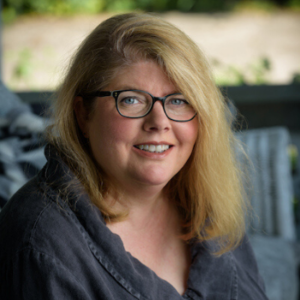Teaching Tips
Mini-interviews with writer/educators who use The Practice of Creative Writing
Gloria Muñoz | Stephanie Vanderslice | Lauren Cross
Sample Syllabus
Gloria Muñoz  is a Colombian American writer, translator, and editor. She is the author of Danzsirley / Dawn’s Early, which was awarded the Academy of American Poet’s 2019 Ambroggio Prize (forthcoming from Arizona University Press). Gloria's essay "Canta Y (No) Llores" received Lumina's 2020 Multilingual Writing Award. She is also the author of the chapbook Your Biome Has Found You. Her writing has appeared in Vida Review, Puerto del Sol, Acentos Review, LUMINA, The Rumpus, Yes Poetry, Juke Joint, Best New Poets, Sweet Lit, Burrow Press, Cosmonauts Avenue, Entropy, and elsewhere. In the fall of 2019 she was a part of the inaugural Tin House YA Workshop. Gloria teaches creative writing at Eckerd College.
is a Colombian American writer, translator, and editor. She is the author of Danzsirley / Dawn’s Early, which was awarded the Academy of American Poet’s 2019 Ambroggio Prize (forthcoming from Arizona University Press). Gloria's essay "Canta Y (No) Llores" received Lumina's 2020 Multilingual Writing Award. She is also the author of the chapbook Your Biome Has Found You. Her writing has appeared in Vida Review, Puerto del Sol, Acentos Review, LUMINA, The Rumpus, Yes Poetry, Juke Joint, Best New Poets, Sweet Lit, Burrow Press, Cosmonauts Avenue, Entropy, and elsewhere. In the fall of 2019 she was a part of the inaugural Tin House YA Workshop. Gloria teaches creative writing at Eckerd College.
What was your experience teaching The Practice of Creative Writing?
The Practice of Creative Writing is a very cohesive text for new writers. I've taught from the book for the past three years and each year I find new insights the textbook has to offer. It's been my go-to text for multi-genre introduction to creative writing courses.
What do your students like about the book?
Students like the structure of each chapter. They learn through craft, the readings and then they are able to put what they learn into practice with the writing prompts. I think students also appreciate that the textbook is also written in a colloquial and inviting style.
Any tips for teachers using the book?
Use the exercises in the back of each chapter. They are usually pretty quick to complete and they are illustrative of the craft that students learn in each chapter.
Stephanie Vanderslice's  column, The Geek's Guide to the Writing Life, appears regularly in the Huffington Post. Her essays and stories have been featured in the Fiction Writer's Review, American Literary Review, Ploughshares Online, Knowing Pains: Women on Life, Love and Work in our 40's, Easy Street and many others. A Professor of Creative Writing and Director of the Arkansas Writer's MFA Workshop at the University of Central Arkansas, she has also written several books on teaching creative writing.
column, The Geek's Guide to the Writing Life, appears regularly in the Huffington Post. Her essays and stories have been featured in the Fiction Writer's Review, American Literary Review, Ploughshares Online, Knowing Pains: Women on Life, Love and Work in our 40's, Easy Street and many others. A Professor of Creative Writing and Director of the Arkansas Writer's MFA Workshop at the University of Central Arkansas, she has also written several books on teaching creative writing.
What is your experience teaching The Practice of Creative Writing?
I have been teaching The Practice of Creative Writing in my Introduction to Creative Writing courses since the very first edition was available and have never looked back. I love the fact that the book is organized around threshold concepts in creative writing, because that's how I teach the introductory course. The concept-based method also gives students a baseline for approaching any genre and the concepts themselves make the course more transferable to other writing they might need to do in future courses. This is especially important as the introductory creative writing course more and more finds a place in general education programs across the country, including at my own university. The Practice of Creative Writing allows me to teach creative writing majors and non-majors alike and to fine-tune the course to them in different ways.
What do your students like about the book?
A few of the many things students like about the book is Sellers' voice—wise, funny, engaging and eminently readable. Students feel like she understands where they are coming from, that she's "been there." They also like the readings—the examples in this book are diverse and current, not typical of most intro creative writing books--and they encourage students to widen their reading tastes.
Any tips for teachers using the book?
My students have really benefited from keeping a journal (in an online class, they keep it online) where they must choose one writing exercise to try per chapter. I explain that this is to give them material to draw from, if they want to, for their longer projects and to give them practice working with the concepts. Also, I have begun using the concepts when we workshop student work. I don't begin workshopping until we have finished the book. Then, each student gets one full class workshop. In their responses to the person being workshopped, I ask the students to choose one concept from the book that resonates for them with the work at hand. It could be because the writer is deploying that concept really well or it could be because it could be deployed better. But this gives them something to focus their response around and it helps to reinscribe the importance of those concepts. For example, a student might choose "tension" and explain, "I think there are ways the author could increase the tension in this piece." Or they might choose "image" and explain," the image of the calla lily worked well in this poem and I would have liked to have seen even more images like that."
As an introduction to the book, I also like to show videos of Heather Sellers talking about writing and her own books (or post links to them in an online class) as a way of helping students connect to her as a real person and to encourage them to seek out these kinds of resources online when they are interested in an author and her work.
 was a finalist for Fourth Genre’s 2020 Michael Steinberg Memorial Essay Contest, and her work has appeared in Catapult. She is the Creative Nonfiction Editor for Sweet: A Literary Confection, and she teaches creative writing and composition courses at the University of South Florida.
was a finalist for Fourth Genre’s 2020 Michael Steinberg Memorial Essay Contest, and her work has appeared in Catapult. She is the Creative Nonfiction Editor for Sweet: A Literary Confection, and she teaches creative writing and composition courses at the University of South Florida.I love this textbook so much. I truly wish everyone would use it. When I first started teaching creative writing, I knew I wanted to teach my courses in a hybrid format so students could see how genres influence each other. The Practice of Creative Writing allowed me to do just that. Because the chapters were separated by key writing strategies—images, tension, energy, insight, and pattern—we were able to focus on a specific strategy every couple of weeks after studying the basics. The writing exercises built within each chapter also gave them the opportunity to see the importance of these strategies in every genre, while also allowing them to test genre boundaries. It also comes with a teaching guide, which was helpful for me as a new teacher.
What do your students like about the book?
Students are used to boundaries, rules, and checklists. This book is written in a way that's accessible for students, it engages those who admittedly don't enjoy reading, and it encourages them to break rules. The writing exercises allow them to try different genres, and even test hybridity, without fear of messing up. Many of my students are new to creative writing, and this book is such an encouraging and inviting text, that even if they only took my class to receive the credit, they wrote work they were proud to share and discuss.
Any tips for teachers using the book?
Many introduction to creative writing classes teach each genre separately, but I truly enjoyed teaching by writing strategy. When first compiling my syllabus, it was difficult to find texts that encourage this approach—especially teaching to students new to creative writing—but The Practice of Creative Writing is such an engaging text that it allowed my students to take risks. For example, some students entered the classroom preferring to write poetry. While they did engage with poetry every week, they also learned how to incorporate insight from creative nonfiction into their poetry. And students who preferred creative nonfiction learned new ways of building tension by reading fiction every week.